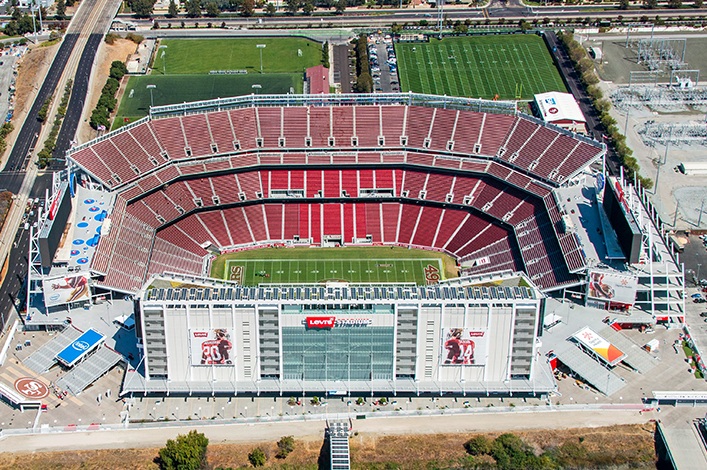
Levi’s Stadium is proof that everyone wins with American-made steel.
The Denver Broncos and Carolina Panthers will do battle in the 50th anniversary of the Super Bowl this Sunday at Levi’s Stadium in Santa Clara, Calif.
And Super Bowl 50 may be the most American of all NFL championships, in part because of the place where it will be played. That’s because Levi’s Stadium was constructed using nearly all American manufactured and fabricated steel.
“I don’t have an exact number, but the steel is pretty close to 100 percent American made,” said Tim Salak, the project manager for SME Steel Contractors. “All of the major structural steel – rolled sections, wide flanges and channel — came out of Nucor in Blytheville, Arkansas.
“There was no Buy America clause for this project, but Nucor-Yamato in Arkansas is where we received all of the milled steel. That’s where we get the majority of our steel for every project.”
Not only is Levi’s Stadium nearly 100 percent Made in America, through a remarkable effort of teamwork, it was erected in five months and came in about $80 million under budget.
The stadium opened ahead of schedule, too. It was supposed to be completed for the 2015 season home opening for the San Francisco 49ers, but because of remarkable design team collaboration, the 49ers were able to play their 2014 home games in the unique, American-made structure.
The construction of Levi’s Stadium stands in stark contrast to that of the nearby San Francisco-Oakland Bay Bridge. California officials opted to use Chinese-made steel on that project, which has produced many structural problems since its opening. It also ran over budget and took longer than expected.
But Levi’s Stadium shows the concrete benefits of American-made construction.
“Since we source our steel from Nucor, it really was kind of business as usual,” Salak said. “What was unique was the compressed schedule. The design team actually accelerated this schedule and it opened the stadium a year before it was proposed to originally open. So a lot happened, very quickly.”
Approximately 16,500 tons of steel were used on the structural side with a total of 23,501 tons fabricated to complete the entire stadium project. The erection of the stadium steel was 100 percent done by SME Steel Industries through Ironworkers Union local 377 out of San Francisco.
“At one point in time we had over 300 ironworkers on the site at the same day,” Salak said. “So we ran four cranes. This cooperation allowed us to complete all of the steel erection in about five months. It was a group and team effort. Everyone from the design team to the general contractor (Turner/Devcon joint venture) and the sub-contractors provided a true collaboration for a stadium of this size.”
The fabrication was a joint venture between SME Steel and Hirschfeld Steel at its San Angelo, Texas plant. SME Steel, located in West Jordan, Utah, is one of the largest steel fabricators in the American West and has a reliable supply chain available throughout the country.
“SME fabricated three-quarters of the stadium steel and Hirschfeld did one-quarter of the fabrication,” Salak said. “The stairways are all steel and our sister company, Southwest Steel, which is a subsidiary of SME Steel Industries, did all the stairs and miscellaneous steel on the project.”
The steel was milled at Nucor-Yamato in Arkansas then shipped by rail to Salt Lake City, where SME received it and began the fabrication process. The first load of milled steel arrived at SME in June 2012 and the initial load of fabricated product was trucked to the construction site by July 30, 2012. Erection began immediately and was completed on December 2, 2012.
Levi’s Stadium has an open design anchored with spacious entry plazas, Photovoltaic panels which produce electrical currents by being exposed to light and the sun and a green roof. The fourteen acre stadium features 68,500 seats with 9,000 luxury seats and the ability to expand to 75,000 seats for Super Bowl 50.
The structure is the first in the NFL to be able to resist seismic loads utilizing Core Brace buckling restrained braces (BRBs). There are 529 Core Brace BRBs built into the stadium. Core Brace is another subsidiary of Utah’s SME Steel Industries.
Through these tireless efforts of all construction crews involved, Super Bowl 50 will be truly American-made. Whether quarterback Peyton Manning earns one last title before retiring from football or the young Carolina Panthers continue this year’s dominance, there will be thousands of workers watching the game with the knowledge they had a hand in creating a spectacular American symbol.
